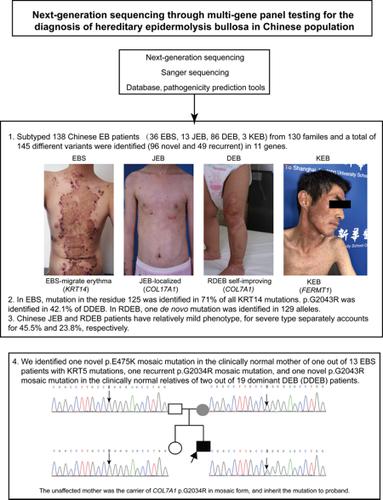当前位置:
X-MOL 学术
›
Clin. Genet.
›
论文详情
Our official English website, www.x-mol.net, welcomes your feedback! (Note: you will need to create a separate account there.)
Next-generation sequencing through multigene panel testing for the diagnosis of hereditary epidermolysis bullosa in Chinese population.
Clinical Genetics ( IF 3.5 ) Pub Date : 2020-06-02 , DOI: 10.1111/cge.13791 Fuying Chen 1, 2 , Linting Huang 1, 2 , Changcan Li 3 , Jia Zhang 1, 2 , Weiqin Yang 1 , Beibei Zhang 1 , Huaguo Li 1, 2 , Dan Deng 1, 2 , Jianying Liang 1, 2 , Jinwen Shen 1, 2 , Zhirong Yao 1, 2 , Ming Li 1, 2
Clinical Genetics ( IF 3.5 ) Pub Date : 2020-06-02 , DOI: 10.1111/cge.13791 Fuying Chen 1, 2 , Linting Huang 1, 2 , Changcan Li 3 , Jia Zhang 1, 2 , Weiqin Yang 1 , Beibei Zhang 1 , Huaguo Li 1, 2 , Dan Deng 1, 2 , Jianying Liang 1, 2 , Jinwen Shen 1, 2 , Zhirong Yao 1, 2 , Ming Li 1, 2
Affiliation

|
Epidermolysis bullosa (EB) is a heritable blistering disorder. We performed a next‐generation sequencing‐based multigene panel test and successfully predicted 100% of the EB types, including, 36 EB simplex (EBS), 13 junctional EB (JEB), 86 dystrophic EB (DEB), and 3 Kindler EB. Chinese JEB and recessive DEB (RDEB) patients have relatively mild phenotypes; for severe type separately accounts for 45.5% and 23.8%, respectively. We identified 96 novel and 49 recurrent pathogenic variants in 11 genes, although we failed to detect the second mutation in one JEB and five RDEB patients. We identified one novel p.E475K mosaic mutation in the clinically normal mother of one out of 13 EBS patients with KRT5 mutations, one recurrent p.G2034R mosaic mutation, and one novel p.G2043R mosaic mutation in the clinically normal relatives of two out of 19 dominant DEB patients. This study shows that next‐generation technology could be an effective tool in diagnosing EB.
更新日期:2020-07-15


























 京公网安备 11010802027423号
京公网安备 11010802027423号